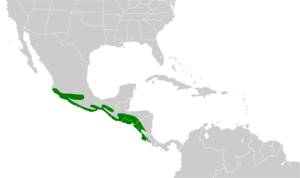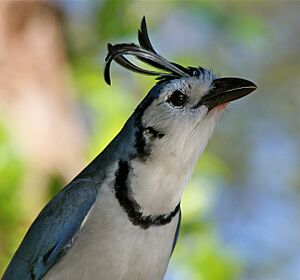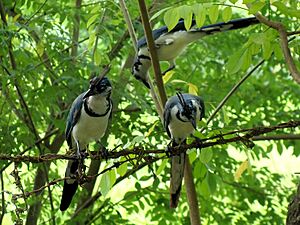White-throated magpie-jay facts for kids
Quick facts for kids White-throated magpie-jay |
|
|---|---|
 |
|
| C. f. pompata, Honduras | |
| Conservation status | |
| Scientific classification | |
| Genus: |
Calocitta
|
| Species: |
formosa
|
 |
|
| Synonyms | |
|
Pica formosa (protonym) |
|
The white-throated magpie-jay (scientific name: Calocitta formosa) is a big, beautiful bird from Central America. It's a type of magpie-jay. You can find these birds living in forests along the Pacific coast. Their home stretches from Jalisco, Mexico, all the way down to Guanacaste, Costa Rica. These magpie-jays are known for being loud and friendly. They often fly around in groups that are easy to spot. Sometimes, they even make a fuss if they see people watching them!
About This Bird
The white-throated magpie-jay was first officially described in 1827. An English scientist named William Swainson gave it its scientific name. He studied a bird that was found in Temascaltepec, Mexico. Swainson called it Pica formosa. The word formosa comes from Latin and means "beautiful."
This bird is one of two types of magpie-jays in the group called Calocitta. This group was named in 1841 by another English scientist, George Robert Gray. The white-throated magpie-jay is the main example for this group.
Sometimes, in Jalisco, Mexico, the white-throated magpie-jay mates with the black-throated magpie-jay. These two birds are very closely related. There are three slightly different kinds, or subspecies, of the white-throated magpie-jay.
- One kind lives only in southern Mexico.
- Another kind lives in southeastern Mexico and western Guatemala.
- The third kind lives from southeastern Mexico down to Costa Rica.
What Does It Look Like?
The white-throated magpie-jay is about 43 to 56 centimeters (17 to 22 inches) long. It weighs around 205 to 213 grams (7.2 to 7.5 ounces). This bird has a very long tail and a slightly curved bunch of feathers on its head. This feathery crest is black on the most common type of the bird. However, on the other two types, the crest has blue or white edges.
The most common type has a white face with a black top of the head. It also has a thin black line around its throat and a small black spot below its eye. The other types have less black on their faces. Their chest, belly, and the underside of their tail are white. Their wings, back, and tail are blue. The tail feathers have whitish edges. Their legs and eyes are black, and their bill is gray. Female birds look a lot like males. However, their blue feathers are not as bright, the black band on their chest is thinner, and their tail is shorter.
Where Does It Live?
The white-throated magpie-jay lives in many different places. These include dry areas and forests that are a bit wet. They live from sea level up to about 1,250 meters (4,100 feet) high. But they usually stay below 800 meters (2,600 feet). You might not see them often in forests with tall cacti. But they are common in thorny forests, forests along rivers, and forests where trees lose their leaves. They also live at the edges of forests and in farms, like coffee plantations.
These birds do not travel long distances when the seasons change. Young male birds will move away from where they were born a few years after they learn to fly. This bird is common in all the places it lives. People's activities do not seem to be a threat to them.
What Do They Eat?
White-throated magpie-jays eat many different things. This means they are omnivorous. They eat both animals and plants. Their diet includes insects like caterpillars, frogs, and lizards. They also eat the eggs and baby birds of other birds. For plants, they eat seeds, fruits, grains, and even nectar from Balsa tree flowers. Young magpie-jays need several years to learn all the ways their parents find food.




